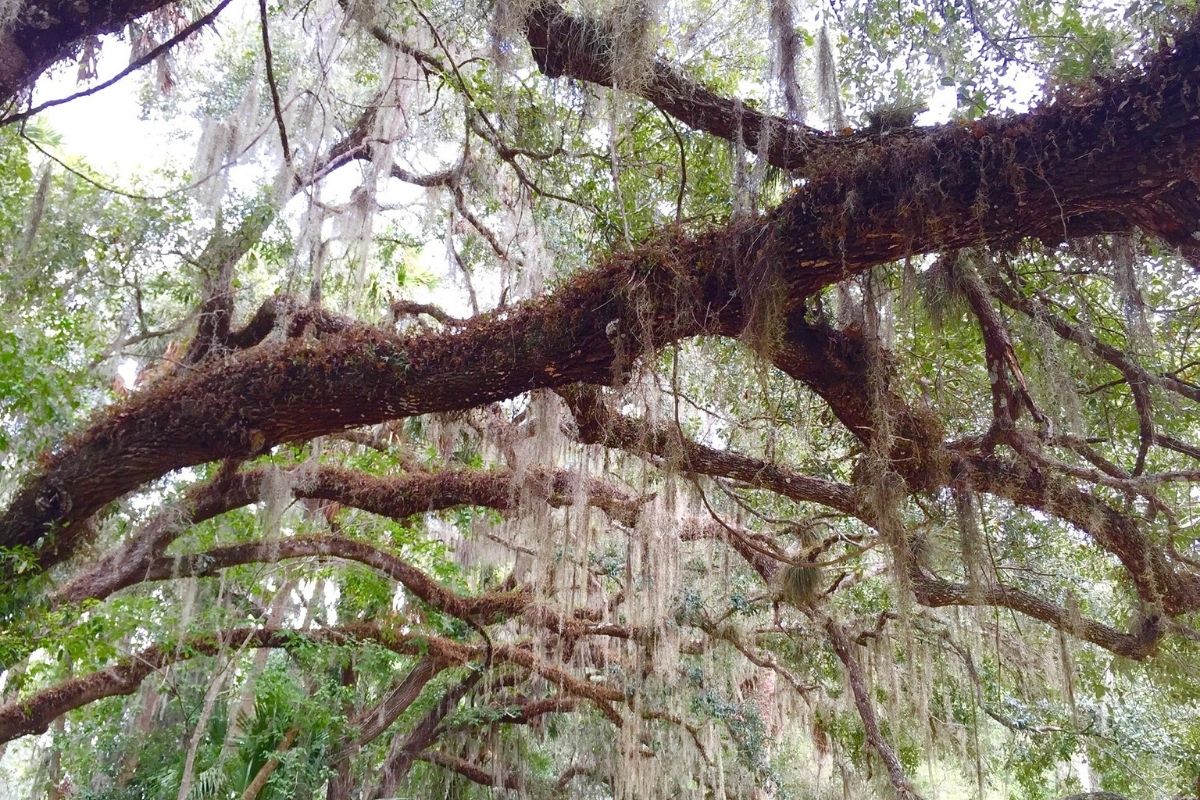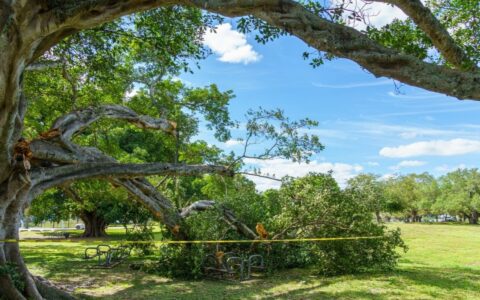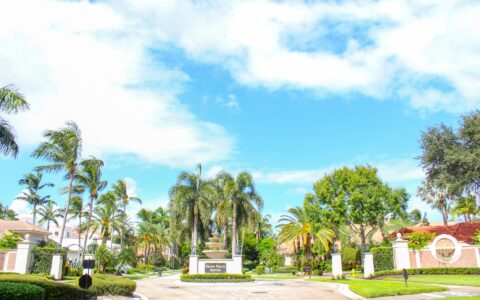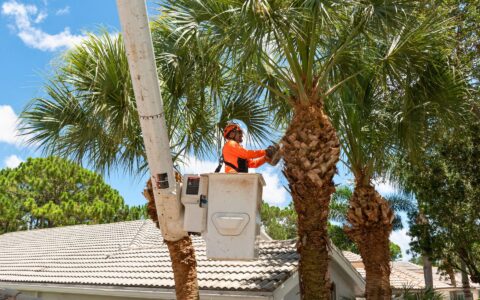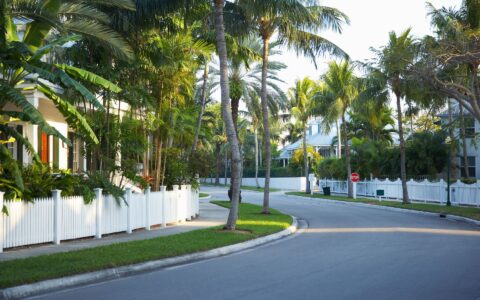Spanish moss elegantly draped across a southern live oak is a well-known sight in South Florida. But while it’s a common sight, many property owners worry that Spanish moss will kill their trees or harm them in some way.
In this article, we cover:
- what Spanish moss is (it’s not what you may think!),
- how it appears in your trees,
- whether Spanish moss harbors pests,
- what you can do with it,
- which trees it’s attracted to (and why),
- the definitive answer on whether or not Spanish moss kills trees,
- how to remove it from your trees (please don’t do this yourself!),
- and more!
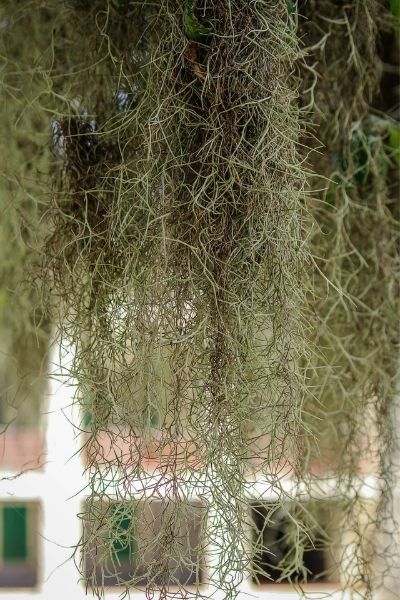
Close-up of Spanish moss, which is not a moss but rather a type of air plant.
What is Spanish moss?
Spanish moss (Tillandsia usneoides) is not actually moss. It is also not native to Spain.
Instead, Spanish moss is something called a bromeliad, which is in the same taxonomic family as pineapples. It’s also known as an air plant or epiphyte. Like other epiphytes, Spanish moss has no roots, so it doesn’t “root itself” into your tree.
Spanish moss is light green when full of moisture (like after a rainfall) and gray when dry. It can reach lengths of 20 feet! It is composed of slender stems that have thin, curly leaves and has tiny pale green or blue flowers that are fragrant at night.
If it’s not Spanish, where does the name “Spanish moss” come from?
Like many epiphytes, Spanish moss is native to tropical environments in the southern hemisphere, including Mexico, Central America, South America, and the Caribbean. It’s also found in the United States, where it grows readily in the warm, moist areas of the south, from Texas to Virginia.
Why is it called Spanish moss?
If it’s not a moss from Spain, how did Spanish moss get its name? Native Americans called it “itla-okla,” which means “tree hair.” French explorers began calling it“Barbe Espagnol,” or “Spanish Beard,” because of its resemblance to Spanish conquistadors of the time. Over the years, the name evolved to become Spanish moss.
It has also been called “Old Man’s Beard” and goes by the name “Pele’s hair” in Hawaii.
Does it have any uses (besides decorating a tree)?
Spanish moss has been used for a variety of purposes over the years, from building insulation to mulch to stuffing for mattresses (it reportedly stays cool on hot summer nights). It’s even a key ingredient in evaporative coolers, used in the southwestern U.S., and was used as a blanket and saddle pad during the Civil War. Native Americans, particularly indigenous tribes such as the Timucuan and Seminole, made it into clothing, furniture, medicine, and other items.
These days, you’re most likely to see it used in floral arrangements – though it also works well as mulch.
Does Spanish moss harbor pests?
Several animals rely on Spanish moss for their survival, including bats, lizards, snakes, and certain kinds of spiders (but we wouldn’t call any of those “pests”). Birds love using these air plants for nesting materials, and boll weevils are drawn to it.
There is debate over whether chiggers are found in Spanish moss as well. Many say that chiggers invade the air plants after they touch the ground, so you should be fine if you’re collecting it off a tree.
How does it attach itself to trees?
It doesn’t attach itself directly to trees. Instead, Spanish moss simply drapes or wraps itself around branches (or other nearby structures, such as wires or fences).
Which South Florida trees are most likely to have Spanish Moss?
Spanish moss can be found on a wide range of tree species in South Florida, including:
- Southern Live Oak
- Bald Cypress
- Sweetgum
- Crepe Myrtles
- Oaks
- Pines (occasionally)
However, it seems to prefer southern live oak and bald cypress. The leaves on these trees leach minerals (calcium, magnesium, potassium, and phosphorus) at a high rate, providing an abundant supply of nutrients to the plant.[13]
Spanish moss is most often found on older, slower-growing trees in areas of high humidity and warm weather. However, it is highly susceptible to pollution so is not found in highly polluted areas.
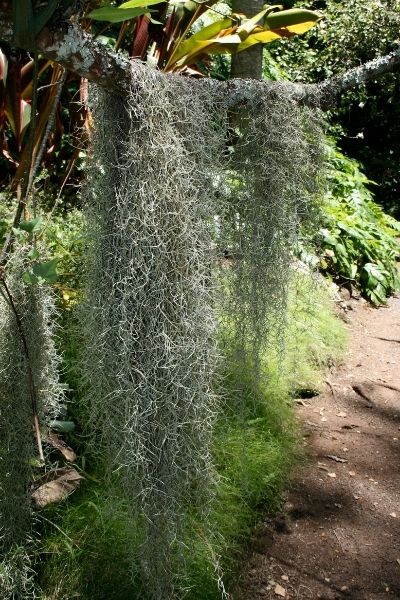
Spanish Moss at the McBride Garden in Hawaii
Will Spanish moss kill my tree?
Most property owners are concerned about Spanish moss because of the fear that it might kill their trees. There’s no need to worry though – Spanish moss will not kill your tree. It is not a parasite; it only uses trees for support, not for nutrients. Instead, it receives nutrients and water from the air, using small openings in its scaly stems to absorb rainfall and humidity.
Of course, too much of anything can be a bad thing. There are instances where the moss becomes so thick that it prevents light from reaching some of the leaves on a tree, slowing the growth of that tree. Usually, this happens on a tree that was already in decline.
Because Spanish moss needs plenty of light to grow, you will sometimes see it on trees that are in poor health. It needs plenty of sunlight to grow, and trees with less foliage provide more sunlight.
If a tree is old and/or brittle, Spanish moss on a limb can cause the limb to crack and possibly fall. But if the slight weight of Spanish moss caused an issue, chances are that the tree was already in a fragile state.
If you have trees extensively covered by large festoons of Spanish moss, keep an eye on them after heavy rainfalls. The moss absorbs and retains water, making it much heavier than it usually is and increasing the risk of breakage (or even bringing down the whole tree).
If you’re concerned that your tree may have some weak branches that are covered with Spanish moss, contact Sherlock Tree for a consultation. We may use cabling or bracing to support weak limbs or prune out the weak branches. And, of course, we’ll let you know if there’s an underlying issue.
What should I do if my tree has Spanish Moss?
Leave it where it is! Spanish moss is an important part of South Florida’s ecosystem and creates a beautiful grey draping feature that can only be found in certain parts of the world.
Then again, if you don’t like the look of it in your trees or if it’s covering up most of the tree, there’s always the option of removing it.
How can I remove it from my trees?
No herbicides are labeled for controlling Spanish moss in trees so removing it by hand is the only choice.
If you are concerned about a cracked branch or weak limb, you can thin out the Spanish moss on that branch by pulling it off. Just be careful of any critters who have made their home there. And please don’t use an unstable ladder or climb the tree to reach the moss!
For more extensive removal, call in a tree care specialist to remove the moss for you. The job usually calls for special equipment, such as a bucket truck or spider lift, to reach all of the branches covered in Spanish moss.
Just know that it will usually grow back in time – or be carried to your tree by birds. It’s almost impossible to completely prevent moss from growing on trees in South Florida.
Spanish Moss grows faster on unhealthy trees, so the best way to keep it from taking over your trees is to keep your trees healthy with regular tree maintenance.
Do other types of Tillandsia also grow in trees?
Ball moss (Tillandsia recurvate) is also commonly found on trees in Florida, as are a number of other air plants. But the one to watch out for is Tillandsia xerographica, known as the “King of Air Plants,” which can grow up to 3 feet wide. Like other epiphytes, it doesn’t directly harm the tree; rather, it’s an indicator that there could be an underlying problem with the tree. It seems to prefer anchoring itself to dead or dying branches so if you see a lot of it in your tree, call an arborist for a thorough tree inspection. In contrast, Spanish moss will grow anywhere, not just on areas with dieback.
Can I use Spanish moss for mulch?
Spanish moss absorbs and retains moisture, making it a good garden mulch. But, it needs to be collected and cleaned first. Check out this guide on how to gather the moss, sanitize it, and use it on your property.
If you remove Spanish moss for your trees but don’t want to use it as mulch, you can dry it out and use it as tinder for starting bonfires in a fire pit or safe location.
A Final Word About Spanish Moss on Trees
Spanish moss cannot harm your tree, but it can expose some underlying issues. This air plant, which is neither moss nor Spanish, provides some elegance and drama for old, sturdy trees, as well as shelter and nesting material for many species.
If you have any questions about Spanish moss in your South Florida landscape, or if you’d like it removed from trees on your property, contact the arborists at Sherlock Tree for a consultation.
Call Sherlock for quality tree services
Whether you're looking for specific tree care services, such as palm trimming, tree removal, or disease treatments, or would like one of our Arborists to examine your trees to identify any issues and recommend options, we're always here for you! Just give us a call at 954-788-4000 to set up an appointment.
SEE MORE ARTICLES
Looking for more?
We've got you covered with a monthly newsletter full of tips, resources, updates, how-to's, and other helpful information about trees and landscapes in South Florida!

